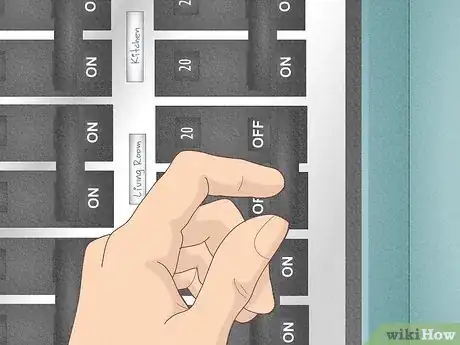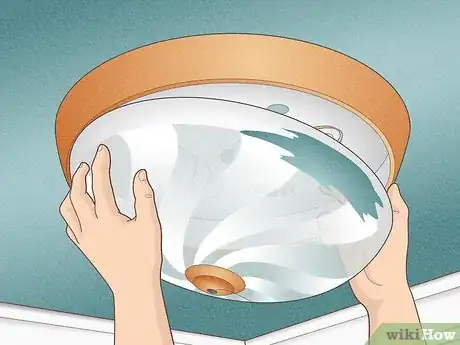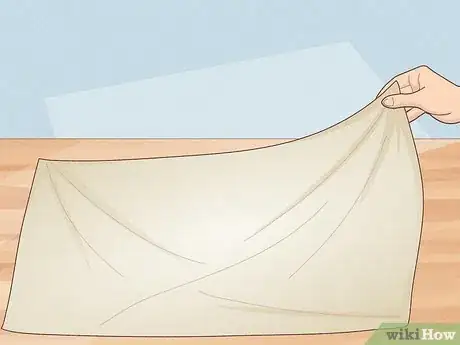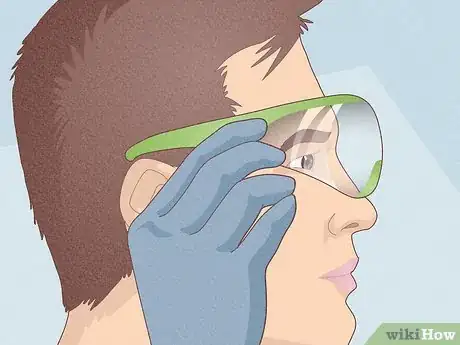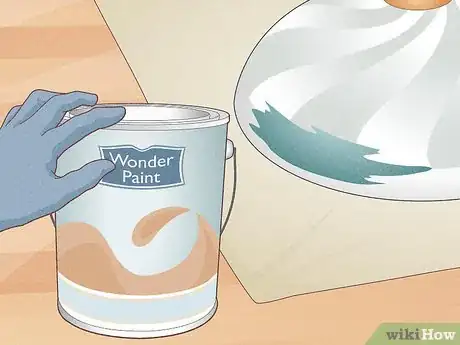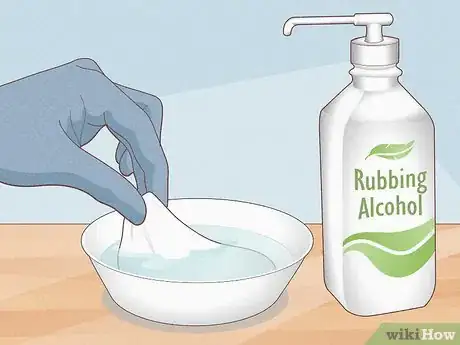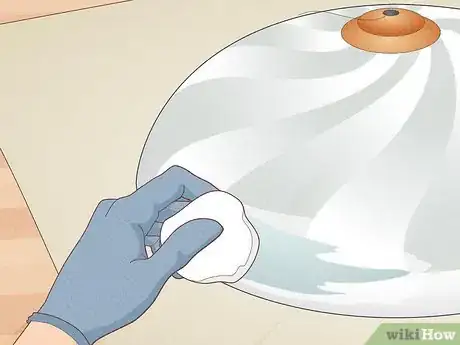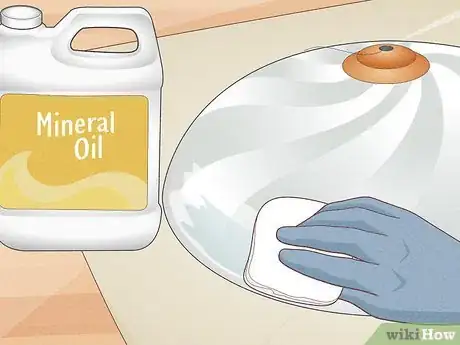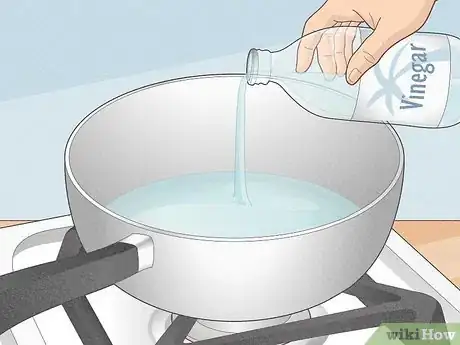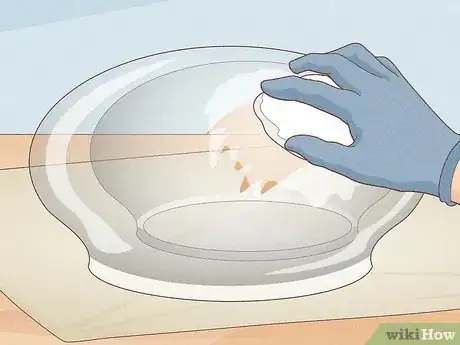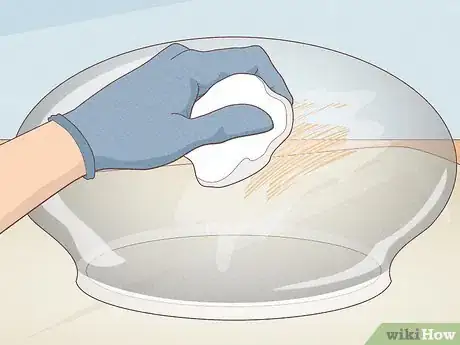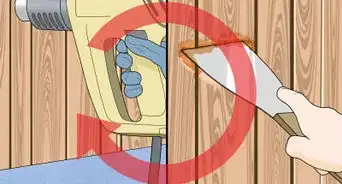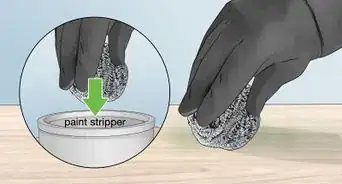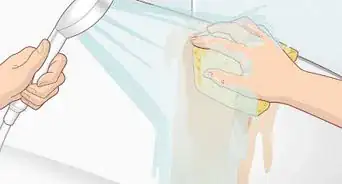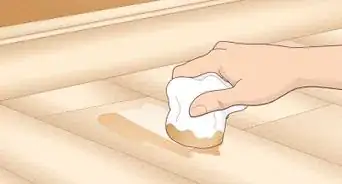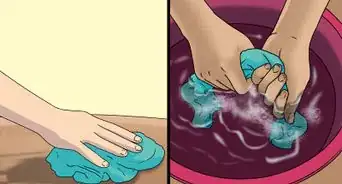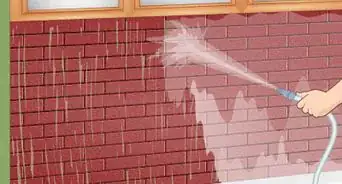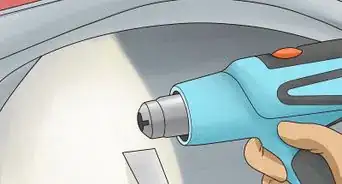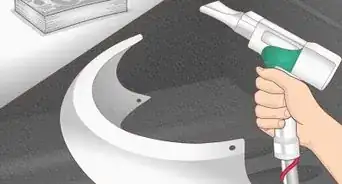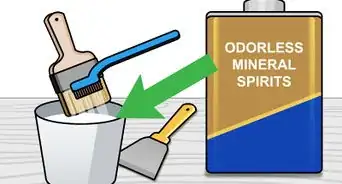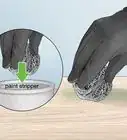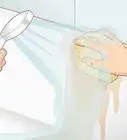This article was co-authored by Jeff Baldwin. Jeff Baldwin is a Residential Painter and the Owner of Baldwin Custom Painting. With two decades of painting experience, Jeff specializes in high-end residential and small commercial painting projects. Dedicated to quality craftsmanship, Jeff and Baldwin Custom Painting provide bonded/insured, licensed, and lead-safe certified services in residential painting, light commercial painting, and wood refinishing.
There are 7 references cited in this article, which can be found at the bottom of the page.
This article has been viewed 58,604 times.
Sometimes, in the course of painting a room or ceiling, a small amount of paint will end up on a light fixture. Or maybe it was painted on purpose to create a new look. Either way, if you want to remove it, you can easily strip it from both the fixture and glass with a little elbow work and patience.
Steps
Creating a Safe Workspace
-
1Shut off the power. Whether you are removing the light fixture from the ceiling or wall, or stripping it as it is, cut off the electricity before you start. Go to your circuit breaker or fuse box. Switch off the appropriate circuit or unscrew the correct fuse. Eliminate the risk of electrical shock and injury.[1]
- If your circuits or fuses are missing labels, either shut off all the power or test each one until you find the correct one.
-
2Remove the light fixture. If possible, favor taking it down over cleaning it where it is. Reduce the chance of stripping paint from the ceiling or wall by accident. Work in an area of your choosing, with proper ventilation and safer footing than a ladder. Exact instructions for removing light fixtures will vary according to their design, but generally they follow these points:[2]
- Taking light bulbs out to avoid damage.
- Unscrewing the plate from the mounting bracket in the ceiling.
- Using a circuit tester to confirm that the wiring is powerless.
- Disconnecting the wiring.
Advertisement -
3Protect other surface areas. Lay down a dropcloth, tarp, newspapers, or similar material over the floor. If you have removed the light fixture, also cover your worktable. If you are using more than one covering, check for gaps between them. If you are keeping the fixture in place, apply painter’s tape around it to protect the ceiling or wall.[3]
- Drips from the cleaning agent may strip paint or otherwise mar other surfaces.
-
4Protect yourself. Wear cleaning gloves. Protect your eyes with safety glasses, especially if you are working from underneath the fixture. If using a ladder, make sure it is high enough to work safely, rather than overreach and lose balance on a shorter ladder. Open windows and use fans to create cross-breezes for circulation.[4]
- Fumes from cleaning agents may be overpowering or poisonous. For long projects or areas with poor ventilation, wear a ventilation mask, especially if you are working on a ladder.
Stripping Paint from Fixtures
-
1Determine the type of paint. If you painted the fixture yourself, ask yourself what you used: latex, acrylic, or spray paint.[5] For latex or acrylic, you will need rubbing alcohol to strip it.[6] [7] For spray paint, you will need acetone.[8] If someone else painted it, look for brush strokes, which indicates latex or acrylic paint.
- If you are still unsure, select two separate areas to test each chemical.[9] Do not mix rubbing alcohol and acetone by applying it to the same area. Wipe off whichever one doesn’t work, wipe again with clean water to rinse, and let it dry before using the other.
-
2Soak your cleaning cloth. If the area to be cleaned is very small, simply wet a corner with rubbing alcohol or acetone. For larger surface areas, pour the agent into a plugged sink or bowl and soak the whole cloth. Wring out any excess to reduce the chance of accidental drips.[10]
- Both rubbing alcohol and acetone may affect other surfaces if they come into contact by mistake.
-
3Rub the paint. Scrub the surface area with your soaked cloth.[11] Soak the paint first so the cleaning agent has time to be absorbed and loosen the paint’s bond. Then scrub more forcefully to remove the paint.[12]
- Due to the heat generated by light bulbs, the paint may have baked onto the surface, which may make rubbing ineffective.[13]
- However, always start with cloths to see if that works, since harder tools may damage the metal, wood, or plastic.
-
4Soak the paint with mineral oils if necessary. If rubbing with a cloth doesn’t work, use a utility knife to cut X’s in the paint. Apply as little pressure as possible to avoid nicking the fixture’s original surface. Then soak a new cleaning cloth with mineral oils and wipe it over the paint. Give it a half-hour or more to sit. Then try rubbing the paint off again. Repeat as needed.[14]
- Depending on how thick the paint it is, this may require several soaks. Very thick coats may require a few days’ worth of repeated applications.
Removing Paint from Glass
-
1Make your cleaning solution. Pour equal parts white vinegar and clean water into a pot. Stir to mix. Set the pot on an oven burner and turn the heat to medium-high. Bring the solution to a boil.[15]
-
2Wet your cleaning cloth. First, put on a pair of heat-resistant cleaning gloves. Protect your hands from scalding, since you want to use the solution while it’s still hot. Immerse a portion of your cleaning cloth into the water. Squeeze out the excess to avoid dripping boiled water on yourself.[16]
-
3Soak the glass. Gently rub the cloth over the painted area, rewetting as necessary. Worry less about removing the paint at first and more about soaking it. Let the heated solution weaken the paint’s bond to the glass for easier removal.[17]
-
4Rub the paint off. Rewet your cloth. Scrub the painted area a second time. Apply more pressure this time, but be careful not to break the glass. Scrub the paint clear of the glass as it continues to loosen. Rewet your cloth and repeat as needed.[18]
-
5Scrape if necessary. If any paint refuses to budge, wet the surface area again with your solution. Depending on how long you’ve been working, it may have cooled off by now, so reheat it if you need to. Wait a moment for the paint to soak it in. Then gently scrape the paint off with a utility knife. Work slowly and surely to avoid scratching the glass.[19]
Expert Q&A
-
QuestionHow do you remove paint from vinyl?
 Jeff BaldwinJeff Baldwin is a Residential Painter and the Owner of Baldwin Custom Painting. With two decades of painting experience, Jeff specializes in high-end residential and small commercial painting projects. Dedicated to quality craftsmanship, Jeff and Baldwin Custom Painting provide bonded/insured, licensed, and lead-safe certified services in residential painting, light commercial painting, and wood refinishing.
Jeff BaldwinJeff Baldwin is a Residential Painter and the Owner of Baldwin Custom Painting. With two decades of painting experience, Jeff specializes in high-end residential and small commercial painting projects. Dedicated to quality craftsmanship, Jeff and Baldwin Custom Painting provide bonded/insured, licensed, and lead-safe certified services in residential painting, light commercial painting, and wood refinishing.
Residential Painter Spray some latex paint remover on the dried water-based paint. Leave it for a few minutes. Then scrub it with a cloth and warm water.
Spray some latex paint remover on the dried water-based paint. Leave it for a few minutes. Then scrub it with a cloth and warm water. -
QuestionWhat should I do to remove acrylic paint from various surfaces and clothing?
 Jeff BaldwinJeff Baldwin is a Residential Painter and the Owner of Baldwin Custom Painting. With two decades of painting experience, Jeff specializes in high-end residential and small commercial painting projects. Dedicated to quality craftsmanship, Jeff and Baldwin Custom Painting provide bonded/insured, licensed, and lead-safe certified services in residential painting, light commercial painting, and wood refinishing.
Jeff BaldwinJeff Baldwin is a Residential Painter and the Owner of Baldwin Custom Painting. With two decades of painting experience, Jeff specializes in high-end residential and small commercial painting projects. Dedicated to quality craftsmanship, Jeff and Baldwin Custom Painting provide bonded/insured, licensed, and lead-safe certified services in residential painting, light commercial painting, and wood refinishing.
Residential Painter You can use a latex paint remover and a small firm bristle brush to remove acrylic paint from various surfaces and clothing.
You can use a latex paint remover and a small firm bristle brush to remove acrylic paint from various surfaces and clothing. -
QuestionI have an electrified Moroccan lantern made of tin. The paint has come off in a few places. Could I use an electric stripper?
 Community AnswerYes, that can work. Along with what the article says, paint strippers are a good alternative.
Community AnswerYes, that can work. Along with what the article says, paint strippers are a good alternative.
Warnings
- Contact a professional electrician to remove light fixtures if you aren’t certain on how to do it.[20]⧼thumbs_response⧽
- Rubbing alcohol and acetone are both flammable.[21]⧼thumbs_response⧽
- Prolonged inhalation may cause dizziness, headaches, increased heart rate, and nausea.[22]⧼thumbs_response⧽
- Inhalation and direct contact with acetone may also cause acetone poisoning in rare cases.[23]⧼thumbs_response⧽
- Clothes should not be reused or machine-washed or -dried.
Things You’ll Need
For safety:
- Cleaning gloves
- Protective eyewear
- Drop cloths or other protective covering
- Ventilation
- Ventilation mask
For fixtures:
- Lint-free cleaning cloth(s)
- Rubbing alcohol or acetone
- Utility knife
- Mineral oils
For glass:
- White vinegar
- Water
- Pot
- Oven
- Heat-resistant cleaning gloves
- Lint-free cleaning cloth(s)
- Utility knife
References
- ↑ http://www.apartmenttherapy.com/how-to-remove-a-light-fixture-176020
- ↑ http://www.apartmenttherapy.com/how-to-remove-a-light-fixture-176020
- ↑ http://www.bobvila.com/articles/how-to-remove-paint-from-metal/
- ↑ http://www.diybudgetgirl.com/removing-paint-from-metal/
- ↑ Jeff Baldwin. Residential Painter. Expert Interview. 1 March 2021.
- ↑ http://www.creeklinehouse.com/2013/04/how-to-get-rid-of-paint-spills.html
- ↑ http://www.diybudgetgirl.com/removing-paint-from-metal/
- ↑ http://www.diybudgetgirl.com/removing-paint-from-metal/
- ↑ Jeff Baldwin. Residential Painter. Expert Interview. 1 March 2021.
- ↑ http://www.diybudgetgirl.com/removing-paint-from-metal/
- ↑ http://www.diybudgetgirl.com/removing-paint-from-metal/
- ↑ Jeff Baldwin. Residential Painter. Expert Interview. 1 March 2021.
- ↑ http://itchyfish.com/tips-for-removing-paint-from-light-fixtures/
- ↑ http://itchyfish.com/tips-for-removing-paint-from-light-fixtures/
- ↑ http://www.apartmenttherapy.com/a-nontoxic-scra-109180
- ↑ http://www.apartmenttherapy.com/a-nontoxic-scra-109180
- ↑ http://www.apartmenttherapy.com/a-nontoxic-scra-109180
- ↑ http://www.apartmenttherapy.com/a-nontoxic-scra-109180
- ↑ http://www.apartmenttherapy.com/a-nontoxic-scra-109180
- ↑ http://www.apartmenttherapy.com/how-to-remove-a-light-fixture-176020
- ↑ http://www.diybudgetgirl.com/removing-paint-from-metal/
- ↑ http://www.diybudgetgirl.com/removing-paint-from-metal/
- ↑ http://www.diybudgetgirl.com/removing-paint-from-metal/
